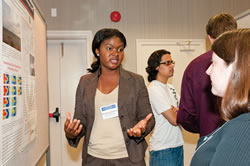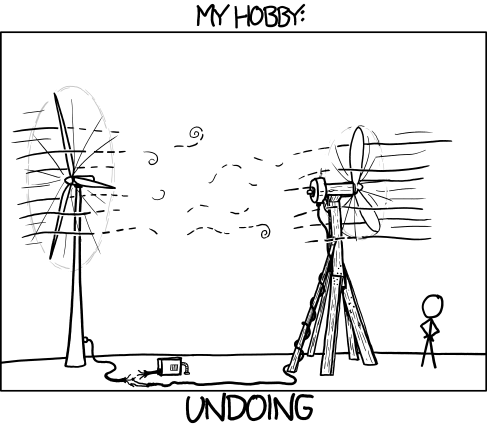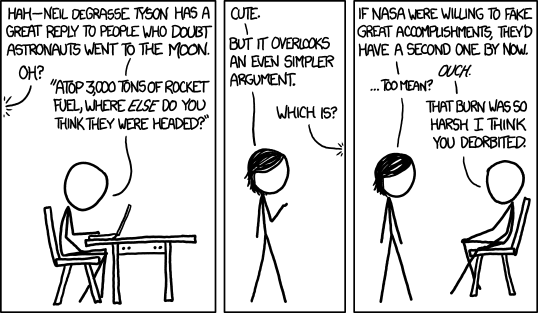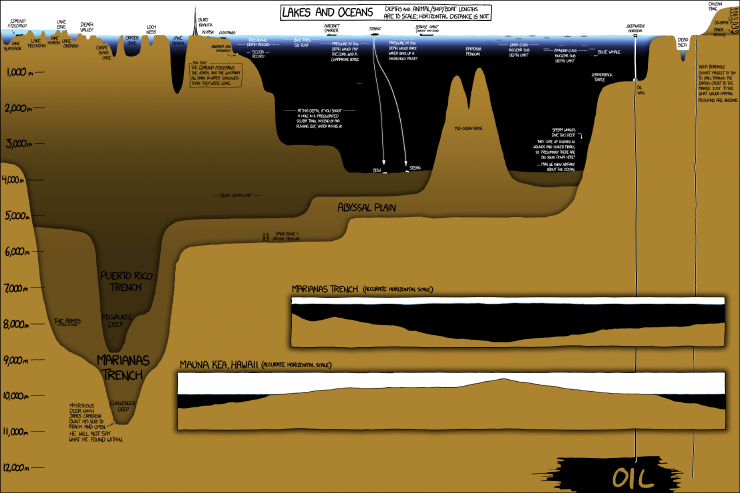Friday, December 14, 2012
Sorry Fbook followers of the Purple Crow Lidar
Of particular note is the sad news I got yesterday about “austerity” (the newest swear word in the language) mercilessly striking the American Geophysical Union.
The Crow
ps I’m dumping all PCL tweets to Fbook now, if it gets to be TMI I’ll try to resolve this somehow.
Tuesday, December 11, 2012
“Detector box, you’re awesome”
- Robin: “Detector box, you’re awesome”
- Box: “Ahhh Robin, come on you did all the aligning, I just recorded the photons”
Congratulations to Crow @Robin_Wing for successfully defending his MSc thesis!
Monday, October 15, 2012
Friday, October 12, 2012
Daring Fireball on Mars Curosity computing specs
Amazing how modest the processing power and software system is on state-of-the-art equipment. As I remember it took until the late 80’s before 8086 processors where flight-certified by NASA.
HonkHonkHonk: Western installs new Weather Siren
Sirens! Harpies! Draw us to the rocks on Western Road will ye she-devils. Send warning to all that neither driving rain, sleet or icy winds shall stop the University of Western Ontario from its mission of destiny!
Terrifying #xkcd on wind power and turbulence
Badges? We don’t need no badges!
Friday, October 5, 2012
Thursday, October 4, 2012
Misconduct, Not Error, Accounts For Most Scientific Paper Retractions
Brought to my attention from my colleague Prof. deBruyn in Physics. 67.4% of the medical papers retracted were due to misconduct not errors!
Monday, October 1, 2012
@cpsx ‘ers: take a virtual tour of the Japanese space agency!
Google Lat Long: Explore the Forefront of Japanese Space Science
Follow the links (and the Google tricycle) around the JAXA Space museum!Google Lat Long: Explore the Forefront of Japanese Space Science wi...: September 12th is “Space Day” in Japan, and we are celebrating by releasing new, comprehensive Street View imagery for two of Japan’s top s...
Aurora Seen from Northern Ontario: 1 October 2012
Sunday, September 23, 2012
Recollections of the ISSI Lidar Temperature and Ozone Algorithms Working Group: Meeting 3
Our working group leader Thierry had us marching along in tight formation all and we obediently followed (for a bunch of scientists).
Friday, September 21, 2012
Duck sets the Record Straight on Canadian Arctic Science
Disturbing words from Canada’s Enviroment Minister Peter Kent. This past week he wrote a letter to the Victoria Times-Colonist mis-representing several important facts about the Harper Government’s brutal, targeted cuts on Arctic science. Prof. T. Duck (Dalhousie University) replies to Kent’s misrepresentation of the facts in a letter to iPolitics.ca, concluding:
… point-by-point Kent’s claims about PEARL are factually incorrect. Many other claims in the Times-Colonist letter have been so profoundly discredited that it is no small wonder he had the gall to utter them. This past week, in response to criticism he had “misled Canadians”, Kent told an opposition MP that she should talk to “better informed scientists”. What we really need is a better-informed Minister.
I encourage you to read the rest of Prof. Duck’s letter on iPolitics.ca.
Saturday, September 1, 2012
Wednesday, August 22, 2012
Congratulations to Crow Emily on winning the William H. Wehlau award!
Crow Emily was recently recognized as the top student in the Astronomy graduate program: (via the UWO Physics & Astronomy Blog). She is shown being presented the award by Astronomy Prof. Amelia Wehlau at the Department picnic. We Crows are all so proud of Emily!
Friday, July 20, 2012
Moon Landing
FML: Google buys Sparrow Mail
added 30 July 13: put tumblr on that list as well!
Monday, July 2, 2012
Leap Second Bug Causes Glitches for LinkedIn, Reddit, More
Ah #Romana it is a simple matter of time.
Wednesday, June 6, 2012
Venus Transit Event @westernu
The Hubble Space Telescope also captured the event.
Monday, June 4, 2012
Canadian Environmental Day of Protest
Saturday, June 2, 2012
Mysterious Light in the Sky
Fortunately he found this blog and figured out what was going on. So those in the Northern part of London, ON watch those skies north of the city on clear nights and you might see our beam!
Friday, June 1, 2012
Comparisons with the NASA ALVICE lidar are in Progress, so… Why Measure Water Vapour in the Upper Atmosphere?
The ALVICE system is mobile, meaning that it can be transported in a self-contained trailer. The system can measure water vapor mixing ratio, aerosol backscatter/extinction/depolarization and temperature in both daytime and nighttime. The ALVICE group is not just from NASA but includes students and faculty from Howard University in Washington DC, as well as collaborating scientists from Brazil and Bolivia.
The goal of our measurements over the next month is to compare our measurements to validate our system calibrations, by inter-comparisons, balloon measurements, calibration sources and satellites. The balloon measurements include regular weather balloons plus ozonesondes and frost point hygrometers, which are carried up by a balloon into the stratosphere to measure the small (a few ppmv) but important amount of water vapour present (1 ppmv means in a cubic litre of air in the lower stratosphere for every million air molecules there is 1 water vapour molecule). The PCL has been able to do these validation checks in the past in the lower and middle troposphere (the lower part of the atmosphere below about 12 km altitude) but has not had the ability to validate its measurements in the upper troposphere and lower stratosphere (the UTLS).
The UTLS is of great importance in large part due to water vapour, as water vapour is important in the chemistry of ozone. If the temperature changes in the troposphere it affects the amount of water vapour which can mix into the stratosphere and interact with ozone. Assessing this situation is complicated. Weather and climate are highly complex systems that are fully nonlinear, meaning that small changes to the system in one location can cause large feedbacks throughout the system. Weather is inherently highly variable, particular at middle latitudes. To make matters more complicated, humans have a significant affect on the already highly unstable natural cycle. The body of evidence shows we are in a period of rapid warming near the surface that is due to human activity, which appears to be having significant affects on the weather. To further complicate the affect of temperature change, for a significant period of time we released a large amount of chlorofluorocarbons into the lower atmosphere, which made there way into the stratosphere and caused unnaturally large ozone losses, particularly at the poles (e.g. polar ozone holes). Goals of the NDACC program include trying to understand these interactions be making long term measurements of water vapour, ozone and temperature.
| An image from the International Space Station shows a pileus cloud forming over the Sarychev volcanic eruption in 2009 (from the Wikipedia page on Pileus Clouds). |
It is just now being recognized another factor which can affect water vapour and ozone in the UTLS is due to forest fires. We are already at the start of what is appearing to be a extremely active fire season. A small number of these fires can develop into huge wildfires that can combine with severe thunderstorms, where vigorous convection is occurring. It was only recently appreciated that this convection can be so strong that smoke particles and carbon monoxide can be carried into the stratosphere and transported great distances. While initial reaction to this idea was met with some skepticism, measurements have clearly demonstrated this is the case. With global warming comes more forest fire activity, and pyroconvection may have significant implications on ozone and temperature change. There has been activity the last few days from fires out West that may bring some of this smoke over the London area.
I will post more updates as the campaign progresses. In fact I just heard we had a successfully FPH flight last night (though it looks like we would need a submarine to recover this one as it landed in Lake Ontario, drat!).
Wednesday, May 23, 2012
Saturday, May 19, 2012
Crow Emily wins Ramsay Memorial Award for Arctic Research
Emily McCullough wins Ramsay Memorial Award - Western Physics and Astronomy WHAT'S HAPPENING:
The Ramsay award has been made annually to a student working in the Canadian Arctic.
Malcolm Ramsay Memorial Award
The Malcolm Ramsay Memorial Award was created in 2000. During his career, he was a biology professor at the University of Saskatchewan and a world-renowned polar bear expert. He played a major role in the studies of many young Arctic researchers and was a strong supporter of the NSTP at the University of Saskatchewan.
Thursday, May 3, 2012
That's odd @NASA upon first meeting Mrs. Sica and saying that I got slapped #SuperMoon #May5
via science.nasa.gov
Tuesday, May 1, 2012
Summer must be here because walking into the lab I stumbled upon a murder of #Crows
As the Oxford English Dictionary suggests, “murder” may “perhaps [allude] to the crow’s ... harsh and raucous cry.”Like when I try to get them to get the lidar going!
Monday, April 23, 2012
Saturday, April 21, 2012
Friday, April 20, 2012
Wednesday, April 11, 2012
The Crows Welcome Back Emily from Eureka. #PEARL #CANDAC
Robin treated us to some delicious cupcakes to celebrate Emily’s return from a successful campaign in Eureka, Nunavut. She is slowly adjusting to the high sun angle and 50 degree warmer temperatures. And working without a parka, toque and mitts!
Monday, April 9, 2012
@xkcd: Lakes and Oceans. How about the Atmosphere next?
Thursday, April 5, 2012
Thursday, March 22, 2012
Petition to Minister Kent to save the Canadian Polar Enviroment Atmospheric Research Lab
Friday, March 16, 2012
When Opinion Trumps Scientific Reason #TheMark #PEARL #ozone #EnvironmentCanada
Or the ideological basis for federal cuts to environmental spending.
The closure of Canada’s Polar Environment Atmospheric Research Lab (PEARL) has shocked many Canadians. Located at 80°N in the High Arctic on Ellesmere Island, Nunavut, PEARL is the northernmost civilian research laboratory in the world. It is internationally recognized for ozone and climate research, and helped discover the first-ever Arctic ozone hole in 2011. PEARL is a Canadian success story that one U.S. government scientist deemed a “national treasure.” Now, many are left wondering why the Canadian government decided to bury that treasure.
Like most university-based environmental-research programs, PEARL depends upon federal grants to operate. However, in recent years, funding opportunities for projects like PEARL have been narrowed or eliminated. Government support for PEARL’s main sponsor, the Canadian Foundation for Climate and Atmospheric Sciences was cut off. Funding that was promised for climate and atmospheric science in the 2011 Federal Budget has been held up for nearly a year. The impact of this funding gap is far from benign. It has forced some of Canada’s best researchers to leave the country to find work. These experts were cultivated in Canada over many years and at great cost. It will take a generation to replace them.
Related: Environment and Economics: A False Dichotomy The funding crisis at our universities mirrors the ongoing cutbacks at Environment Canada (EC). In July 2011, the government announced that it would eliminate 776 positions from EC, with 300 staff to be declared surplus. The cuts are undermining important research and monitoring programs in ozone, atmospheric radiation, climate adaptation, environmental toxics, air quality, and airborne research. Canadians depend upon these programs to ensure their environmental security, health, and safety.
How, then, can the government sufficiently defend these cutbacks?
It’s possible that a scientific review conducted by knowledgeable experts could provide the appropriate justification. However, no such review has taken place. At the 2012 World Economic Forum in Davos, Prime Minister Stephen Harper said that Canada’s investments in science and technology have produced poor results and are a “significant problem for our country.” Given the lack of expert assessment, however, his comments are without merit: They represent his unscientific opinion, and nothing more. Scientists the world over are lamenting what is happening to Canada’s scientific community.
Canadian governments once understood that good policy is informed by science. In 1988, Brian Mulroney’s Progressive Conservatives commissioned independent experts to conduct a review of EC’s ozone program. The resulting report (“Measuring the Impacts of Environment Canada’s R&D: Case Study: Stratospheric Ozone Depletion Research,” 1998) stated that for every dollar spent on the program, Canadians received almost $13 in benefits to their health, environment, and economy. Health benefits included the avoidance of over 57,000 cases of skin cancer, 30,000 cases of cataracts, and 625 deaths in Canada over a 60-year period. Unfortunately, the Harper Conservatives have sought to dismantle what the Progressive Conservatives saw worthy of support.
What’s particularly concerning is that the cuts to Canada’s environmental-monitoring programs are not about money. PEARL costs $1.5 million per year to operate, and EC’s ozone program likely costs about $1 million per year. Compare these costs with those of the government’s flagship programs: The budget for purchasing and servicing one F-35 fighter jet ($246 million, based on calculations from numbers given here) would power PEARL half way into the next century. The budget for new prisons ($9.5 billion) might have seen PEARL into the next ice age. The cost of gazebos and other perks that were built for Muskoka in the run-up to the G8 meeting of 2010 ($50 million) would have supported EC’s ozone program for the next 50 years. The budget for the War of 1812 celebrations ($28 million) could have supported either program for decades.
Related: Obstinate Harper Fuels Pipeline Opposition If money is not the issue, then why is the Canadian government so bent on making cuts to environmental spending? Harper made this clear last year during a trip to the Arctic, when he opined that environmental concerns cannot be allowed to stand in the way of economic development. This is a dangerous attitude. The economy doesn’t exist independent of the environment. A 1990 report from the United Steelworkers explains it best: “The real choice is not jobs or environment. It’s both or neither. What kind of jobs will be possible in a world of depleted resources, poisoned water and foul air, a world where ozone depletion and greenhouse warming make it difficult even to survive?”
Unfortunately, the government has systematically reduced scrutiny of the impacts of its economic and environmental policies by eliminating or crippling important research programs like PEARL. The widespread muzzling of EC scientists has further removed expert opinions from the debate. Clearly, the government cannot protect the future health and safety of Canadians and Canada’s economic viability without reliable information about environmental change. Yet, that is exactly what it is trying to do. It is the triumph of ideology over reason.
Photo 1 courtesy of Hermann Berg; Photo 2 courtesy of Tobias Kerzenmacher.
Op-ed piece from The Mark by Prof. T. Duck of Dalhousie. We continue to ask the question of why funding has been cut for Arctic ozone research when the amount of funding needed to continue this work (per year) is LESS THEN 5% OF RUN-UP COSTS OF THE G8 MEETING IN MUSKOKA (which was actually held 3.5 hours away in Toronto)?
Money, for a change, does not appear to be the issue here.
Monday, March 5, 2012
Sunday, March 4, 2012
Prime Minister Stephen Harper should set scientists free, says Nature #Editorial from #TOstar
Thursday, March 1, 2012
Why Canadians should care about the closure of the PEARL Observatory. #CANDAC @westernu @lfpress @aguscipolicy @saveec @createarcticsci
Why Canadians should care about the closure of the PEARL Observatory
Yesterday we announced the closure of the Polar Environment Research Laboratory (PEARL) located in the high Arctic at Eureka, Nunavut. And what should disturb Canadians about this news has nothing to do with scientific entitlement, belief or disbelief in climate change or signalling our failure as a nation to be able to honour international agreements and commitments. We should be disturbed by the rejection of the notion of our sovereignty by the current Government. Sovereignty has been a cornerstone of the Canadian identify for hundreds of years. Sovereignty is a part of the Canadian mystique, our world-renown ability to stickhandle through difficult situations and find common ground and compromise in chaos.The current Government has in recent months, in addition to closing the PEARL facility, attempted to stop all ozone research by Environment Canada as well as successfully eliminated the Canadian Foundation for Climate and Atmospheric Sciences (CFCAS). This well-coordinated attack on atmospheric science has two major implications for our sovereignty.
- Developing policy. Traditionally when governments are trying to determine future policy actions they need information on which to base their decisions. For instance, how will changing climate affect Canadian agriculture? What affect will future climate changes have on air quality? If the Government is successful and rids itself of scientists investigating climate and weather issues, and further is successful in cutting support to University researchers, where is it going to get its information to make decisions? If you are in business and want to make a plan should you rely on your competitors (e.g. other nations) to provide the best possible advice to benefit you?
- Health of citizens. Another important function of government is risk assessment. For instance, when the Antarctic Ozone Hole was discovered and was found to be growing its affects on humans was felt in New Zealand. It was critical for their government to be informed and know what was happening locally. Last winter measurements from the PEARL Observatory were a critical part of showing the first significant Arctic ozone losses that were at a level of the Antarctic Ozone Hole. We feel it is a responsibility of the Government to monitor atmospheric air quality so they have the knowledge necessary to bring forward policies protecting the health of Canadians. Do we want to rely on getting this information from other nations?
If your Canada includes homegrown scientific research into the environment to allow informed policy decisions and you want Canada to keep a scientific presence in the high Arctic to protect our sovereignty you can write to your MP, the Prime Minister and Minister Kent and let them know how you feel about the closure of the PEARL facility. Contact information is given at the end of this article.
Further Information:
- Dennis Bevington, MP from Western Arctic, NT, questions the Government about the closure of PEARL:
- Read the CANDAC closure notice.
- See the Save PEARL Facebook page.
- Read some facts about CFCAS.. The Canadian Foundation for Climate and Atmospheric Sciences was the only funding available in Canada specifically for scientific investigations of climate and weather. The Harper Government chose to eliminate this program, thus making it difficult for weather and climate research to find support, as existing opportunities are either targeted for specific areas or have as a substantial part of their criteria, revenue generation.
- Article about sovereignty and its role in Canadian history.
- See an example of the Government’s commitment to development in the Arctic.
Contact Information to Let Your Voice be Heard
You can locate your MP’s information at: http://www.canada.gc.ca/directories-repertoires/direct-eng.html. Letters mailed to the following addresses in Canada do not require postage.The Prime Minister address: Office of the Prime Minister, 80 Wellington Street Ottawa, ON K1A 0A2
Fax: 613–941–6900, E-mail: pm@pm.gc.ca
Enviroment Minister Kent can be reached at: The Honourable Peter Kent Minister of the Environment, Member of Parliament for Thornhill (Ontario), Les Terrasses de la Chaudière, 10 Wellington Street, 28th Floor, Gatineau, Quebec K1A 0H3
Tel.: 819–997–1441, Fax: 819–953–0279, Email: Minister@ec.gc.ca
Tuesday, February 28, 2012
#CBCNews High Arctic research station forced to close
Saturday, February 25, 2012
CRL update 20120223
Good morning!
Here's the lidar shining into ice crystals last night while Chris was measuring.
via Crow Emily
Friday, February 24, 2012
Photo of the #CANDAC #Rayleigh #Mie #Lidar back in action from #Eureka #NWT.
Monday, February 20, 2012
Why is this scientist smiling? Read the meter: 981mJ GREEN @ 30Hz. Game on! #lidar
See a few more snaps from the install here.
Thursday, February 16, 2012
Monday, February 13, 2012
Canada dropping the #ozone ball, scientists warn - Politics - CBC News
Saturday, February 11, 2012
Wonderful. Harper govt to cut GSC's Ice Core Research Lab as well #EndOfTheWorldAsWeKnowIt
That makes sense, right? If your trying to erase the present climate record to justify unchecked development you better cover your tracks and deny the last 150,000 years as well!
The horror...
Friday, February 10, 2012
Ouch! From @theAGU #EOS: #EnvironmentCanada Cuts Threaten the Future of Science & International Agreements #ozone
Download the article from AGU's EOS Transactions Newsletter here (pdf).
Monday, February 6, 2012
Man my new office in the P&A building @westernu better have one of these.
Monday, January 9, 2012
Blessing Iserhienrhien in the news: International Conference of Graduate Students Invades Nation’s Capital #uwophysastro

PCL MSc graduate Blessing Iserhienrhien, now working on her PhD at University of Saskatchewan recently presented her work at the Canadian-American-Mexican Graduate Student Physics Conference in Washington, DC. Well done Blessing!
























